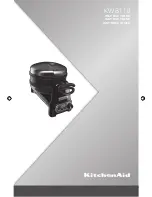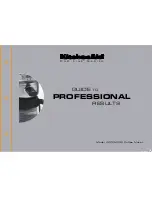
10
7. Place the door back into the skin, keeping the edge covers in
place. Replace the two screws in the top and bottom.
8. Depending on your model, the brand badge for the door of
your ice maker may be in the package with the Use & Care
Guide. Fasten the brand badge to the door.
9. Set the door aside.
Reverse Hinges
1. Unscrew and remove the top hinge. Replace the screws in the
empty hinge holes.
2. Remove the screws from the bottom of the opposite side of
the ice maker cabinet. Turn the top hinge upside down so that
the hinge pin points up. Place the hinge on the bottom
opposite side of the ice maker and tighten screws.
3. Remove the plastic hinge pin sleeve from the “old” bottom
hinge and replace it on the new bottom hinge pin.
4. Remove the “old” bottom hinge screws and hinge. Replace
the screws in the empty hinge holes.
5. Remove the screws from the top of the opposite side of the
ice maker cabinet. Turn the hinge upside down so that the
hinge pin points down. Place the hinge on the top opposite
side of the ice maker and tighten the screws.
6. Remove the top hinge pin.
Replace Door
1. Place plastic hinge pin sleeve in the top hinge hole on the
door. Align the door with the top hinge hole and replace the
top hinge pin.
2. Replace the handle and handle screws (on some models).
Top Hinge
Bottom Hinge
Reverse Door Catch
1. Remove the hole plugs from the opposite side of the door and
set aside.
2. Remove the screws from the magnetic door catch and replace
it on the opposite side of the door.
3. Push the hole plugs into place on the opposite side of the
door.
4. Plug into a grounded 3 prong outlet.
Normal Sounds
Your new ice maker may make sounds that are not familiar to you.
Because the sounds are new to you, you might be concerned
about them. Most of the new sounds are normal. Hard surfaces
such as floors, walls and cabinets can make the sounds seem
louder than they actually are. The following describes the kinds of
sounds that might be new to you and what may be making them.
■
You will hear a buzzing sound when the water valve opens to
fill the water reservoir for each cycle.
■
Rattling noises may come from the flow of the refrigerant or
the water line. Items stored on top of the ice maker can also
make noises.
■
The high-efficiency compressor may make a pulsating or high
pitched sound.
A. Hinge pin
B. Hinge pin sleeve
C. Hinge
D. Hex-head hinge screw
A. Hex-head hinge screw
B. Hinge pin sleeve
C. Hinge
D. Hinge pin
D
C
B
A
D
C
B
A
Electrical Shock Hazard
Plug into a grounded 3 prong outlet.
Do not remove ground prong.
Do not use an adapter.
Do not use an extension cord.
Failure to follow these instructions can result in death,
fire, or electrical shock.
WARNING











































